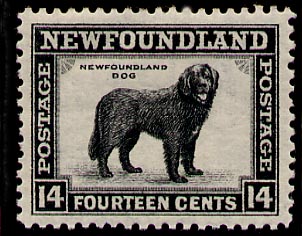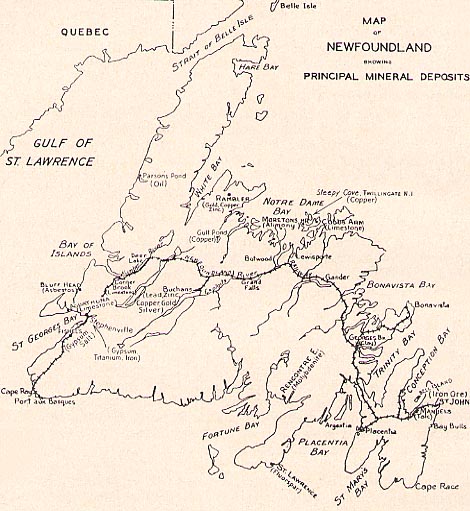
History

 |
Newfoundland History |
 |
Mining in Newfoundland
(to 1949)
[This text was written in 1949. For the full citation, see the end of the document. The more recent developments can be explored at this site. The part in brackets [...], the image and the links have been added to the original text by Claude Bélanger.]
[For an extensive discussion of Pre-Confederation mines in Newfoundland , consult Wendy Martin's Once upon a Mine. The Story of Pre-Confederation Mines on the Island of Newfoundland.] Since much of the island of Newfoundland consists of very ancient rocks, a rich supply of metals is to be expected. Unfortunately only two large fields are in operation at present, the Buchans copper mine; and the Wabana iron mine on Bell island. Between 1888 and 1912 large amounts of copper were obtained at Tilt Cove, but these mines are now unimportant: Discovery of the rather complex lead-zinc-copper ores at Buchans in the Exploits valley was made as early as 1905, but it was not until 1928 that the flotation process enabled these ores to be treated satisfactorily.
The most interesting, mine is Wabana, situated on Bell island in Conception bay, only 20 miles north-west of St.. John's. There ere are three beds of hematite iron ore which dip at a shallow angle under the sea to the north, and many of the workings are under the sea. The first cargo of iron ore left Bell island in 1895 to be smelted with the coal of Pictou , Nova Scotia . In 1899 the Dominion Steel Company purchased the mines, and the ore is now carried to Sydney, Nova Scotia , and smelted at the large steel works in the north-east of that city. There are said to be from 2.5 to 10 thousand million tons of ore available. In 1947 the mine produced 1,280 thousand tons of iron ore.

Newfoundland map of the early 1950's showing the mineral
wealth of the islandCoal, though not abundant, occurs in folded rocks in the western depression near. Deer lake and the Codroy, but very little mining has been done. Fluorspar is found on a commercial scale on Burin peninsula. Manganese is reported from Avalon (near Trepassey), and molybdenum in places on the south coast. There are oil shales near Deer lake which may be used to produce oil when extraction becomes economically feasible. Marble is found on the east coast of the Long Range peninsula, but is not regularly quarried.. Iron ore was discovered in Labrador in 1895, and large deposits of high-grade ore have been mapped along the - upper Kaniapiskau river, but development awaits construction of a railroad by which ore could be, shipped south to the St. Lawrence river .
Bibliography: J. B. Jukes, Excursions in and about Newfoundland (London, 1842),; A. Murray, Report on the geology of Newfoundland (Montreal, 1866); J. P. Howley, Coal deposits of Newfoundland (St. John's, 1918); C. Schuchert, Stratigraphy of western Newfoundland (Washington, 1934); A. K. Snelgrove, Mines and mineral resources of Newfoundland (St. John's, 1938); G. Taylor, Newfoundland, a study of settlement (Toronto, 1946).
Source: W. Stewart WALLACE, ed., The Encyclopedia of Canada . Newfoundland Supplement , Toronto, University Associates of Canada, 1949, 104p., p. 78. Some minor mistakes have been corrected. The text has been reformatted for the web edition.
© 2004 Claude Bélanger, Marianopolis College |